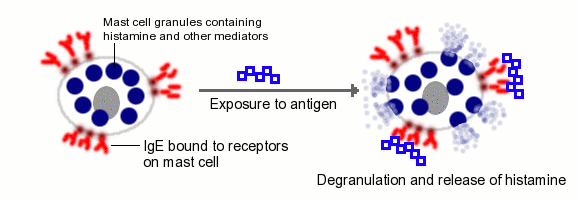VIVO Pathophysiology
Histamine
Histamine is a small molecule derived from the decarboxylation of the amino acid histidine. It is destroyed by the enzyme diamine oxidase (histiminase), which is also involved in the metabolism of other bioactive amines.

Histamine is synthesized in all tissues, but is particularly abundant in skin, lung and gastrointestinal tract. Mast cells, which are present in many tissues, are a prominent source of histamine, but histamine is also secreted by a number of other immune cells. Mast cells have surface receptors that bind immunoglobulin E, and when antigen crosslinks IgE on the mast cell surface, they respond by secreting histamine, along with a variety of other bioactive mediators.

Physiologic Effects of Histamine
Histamine is best known as a mediator of allergic reactions, but it is now recognized to participate in numerous other normal and pathologic processes. The sensitivity and response of a particular cell to histamine depends upon which type of histamine receptor is present on that cell.
 An interesting illustration of the systemic effects of histamine is scombroid fish poisoning. Essentially histamine poisoning, this disorder is seen following consumption of fish, commonly tuna or mackerel, that have spoiled and within which bacteria have generated abundant quantities of histamine from histidine in muscle protein. Consumption of such spoiled fish results in the rapid development of a variety of clinical signs, including headache, sweating, diarrhea, a flushed face, and vomiting, all resulting from systemic exposure to histamine. The lesson here: keep fish refrigerated!
An interesting illustration of the systemic effects of histamine is scombroid fish poisoning. Essentially histamine poisoning, this disorder is seen following consumption of fish, commonly tuna or mackerel, that have spoiled and within which bacteria have generated abundant quantities of histamine from histidine in muscle protein. Consumption of such spoiled fish results in the rapid development of a variety of clinical signs, including headache, sweating, diarrhea, a flushed face, and vomiting, all resulting from systemic exposure to histamine. The lesson here: keep fish refrigerated!
Allergic and Inflammatory Reactions

Histamine playes a pivotal role in many types of allergic and inflammatory processes, including both acute and delayed hypersensitivity reactions. The source of histamine in such cases is tissue mast cells. The magnitude of such problems depends on the route of exposure (local versus systemic), sites of exposure (e.g. inhaled versus cutaneous), the dose of allergen, and the degree of previous sensitization to the allergen. Clinical manifestations of histamine release vary from life-threatening anaphylactic reactions, to uticaria (hives), to local wheal and flare reactions. The image on the right shows a dog with hives due to a drug allergy.
Many of the signs of allergic reaction result from the ability of histamine to affect blood vessels, inducing increased blood flow, vasodilation and increased vascular permeability.
Regulation of Immune Responses
In addition to frank allergic reactions, histamine has significant effects on many aspects of immune reactions by binding to its diverse group of receptors expressed variously on B and T lymphocytes, dendritic cells, macrophages and a variety of hematopoietic cells. Among other things, histamine influences immune cell maturation and activation, secretion of several cytokines, and chemotactic responses of cells.
Secretion of Gastric Acid
Hydrochloric acid is secreted in abundance by parietal cells embedded in the epithelium of the stomach. One of the principle stimuli for secretion of acid by parietal cells is histamine, secreted from neighboring enterochromaffin cells. The histamine receptor on parietal cells is the H2 type, and blocking the binding of histamine to this receptor is a widely used method for suppressing gastric acid secretion.
Smooth Muscle Contraction
Smooth muscle around bronchi in the lungs and within the intestinal tract respond to histmine stimulation by contraction, although the magnitude of response varies considerably among species. These effects also depend on which receptor is being bound by histamine; for example, the H2 receptor mediates bronchodilation. One of the first bioassays for histamine involved measuring contraction of guinea pig intestinal muscle. These effects on smooth muscle are manifest in a number of allergic reactions, for example, bronchocontriction in response to inhaled allergens.
Effects in the Nervous System
Histamine acts as a neurotransmitter within the central nervous system. The (histaminergic) neurons that secrete histmine are localized in small regions of the hypothalamus, but those neurons send axons widely throughout the brain. Histamine appears to modulate a number of important processes in the brain, including wakefulness, cognitive ability and food consumption.
Histamine Receptors and Receptor Antagonists
Four histamine receptors have been identified, all of which are G protein-coupled receptors. These different receptors are expressed on different cell types and work through different intracellular signalling mechanisms, which explains, at least at a simple level, the diverse effects of histamine in different cells and tissues.
| Receptor Type | Major Tissue Locations | Major Biologic Effects |
|---|---|---|
| H1 | smooth muscle, endothelial cells | acute allergic responses |
| H2 | gastric parietal cells | secretion of gastric acid |
| H3 | central nervous system | modulating neurotransmission |
| H4 | mast cells, eosinophils, T cells, dentritic cells | regulating immune responses |
References and Reviews
- Haas HL, Sergeeva OA, Selbach O. Histamine in the nervous system. Physiol Rev. 2008; 88:1183-241.
- Thurmond RL, Gelfand EW, Dunford PJ. The role of histamine H1 and H4 receptors in allergic inflammation: the search for new antihistamines. Nat Rev Drug Discov. 2008; 7:41-53.
- Jutel M, Blaser K, Akdis CA. The role of histamine in regulation of immune responses. Chem Immunol Allergy. 2006; 91:174-87.
- Parsons ME, Ganellin CR. Histamine and its receptors. Brit J Pharmacol 2006; 147:S127-S135. [includes a large amojnt of information on history of discovery for histamine and histamine receptors]
- Thurmond RL, Gelfand, Dunford PJ. The role of histamine H1 and H4 receptors in allergic inflammation: the search for new antihistamines. Nature Reviews Drug Discovery 2008; 7:41-53.
Send comments to Richard.Bowen@colostate.edu
